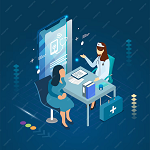


This blog explores the intricacies of EMR/EHR software development, highlighting its importance in modern healthcare.
The healthcare industry has witnessed a digital transformation over the past few decades, with the advent of Electronic Medical Records (EMR) and Electronic Health Records (EHR) playing a crucial role. These technologies have reshaped how patient data is managed, shared, and utilized, making healthcare more efficient and effective. The development of EMR and EHR software is a complex process that requires a deep understanding of healthcare processes, regulatory compliance, and cutting-edge technology. In this blog, we will delve into the nuances of EHR software development, exploring its significance, challenges, key components, and best practices.
Before we dive into the development process, it’s important to differentiate between EMR and EHR.
Electronic Medical Records (EMR) refer to digital versions of the paper charts in a clinician’s office. They contain the medical and treatment history of patients within one practice. EMRs help track patient data over time, identify those who are due for preventive screenings or checkups, and monitor how patients fare on certain parameters such as blood pressure readings or vaccinations.
Electronic Health Records (EHR), on the other hand, are more comprehensive. They go beyond the data collected in a provider’s office and are inclusive of a broader view of a patient’s care. EHRs are designed to be shared with other healthcare providers, so authorized users can access a patient’s information across different healthcare settings, making the data interoperable.
The development of EMR/EHR software is not just about digitizing patient records; it’s about creating systems that improve patient care, enhance clinical workflows, and ensure compliance with healthcare regulations.
Developing EMR/EHR software involves several critical components, each contributing to the overall functionality and effectiveness of the system.
Despite the numerous benefits, developing EMR/EHR software is fraught with challenges. These challenges stem from the complexity of healthcare processes, the need for compliance with stringent regulations, and the ever-evolving nature of technology.
The development of EMR/EHR software is a critical endeavor that has the potential to revolutionize healthcare delivery. By digitizing patient records and streamlining clinical workflows, these systems can improve patient care, enhance efficiency, and ensure compliance with healthcare regulations. However, developing a successful EMR/EHR system requires careful planning, a deep understanding of healthcare processes, and a commitment to security and compliance. By adhering to best practices and overcoming the challenges associated with EMR/EHR software development, developers can create solutions that truly benefit healthcare providers and their patients.
